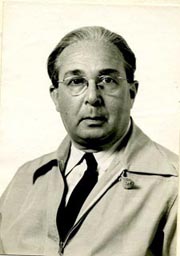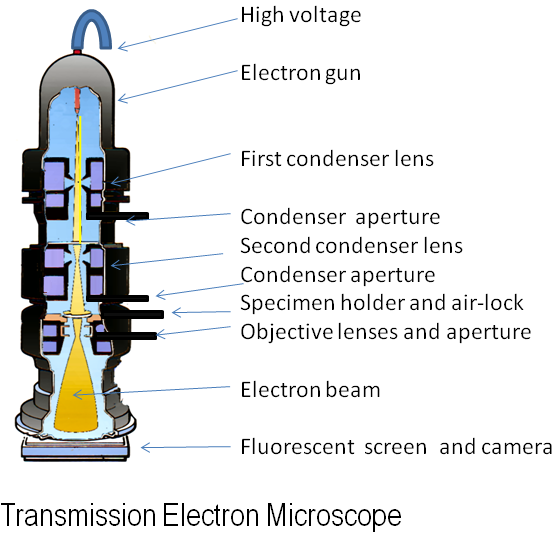The microscope that reduces everything to ashes
The electron microscope, another Einstein-Szilard scam and yet another inappropriate Nobel prize
Basically, a simple device, the electron microscope works just like an optical microscope, but uses electrons and magnets rather than light and lenses. It’s a development of the cathode ray tube, in its simplest terms: the electrons from the cathode are focused by passing them through the magnetic field of a permanent magnet or a charged and magnetised coil of wire. They may also be focused by electrostatic plates. Whatever the method used, it functions as a magnetic lens.
The problem is, that unlike light, the electron beam tends to burn any non-conducting samples. This means that any biological samples need to be plated with gold, osmium, or some other metallic conducting material and become what is often considered an artifact of the original. The original unprotected non-conducting sample would simply be baked to a cinder.

The fact that electron microscopes zap every non-conducting sample, especially bio samples, is played-down as we see here:
scienceblogs.com: Apparently, it’s possible to make your sample really, really hot if you’re reckless. More insidiously, you can alter the elemental distribution of what you are looking at. For some materials, the beam heating can actually cause some atoms to diffuse away from the focal spot. If you are attempting an analysis, you can literally watch the count rate for those elements tail off as they move away.
It can be depressing, as to get usable data you have to alter your analytical conditions, then restandardize, then find a new spot to zap.
http://scienceblogs.com/builtonfacts/2009/07/28/electron-microscopes/
Patent
It could be said that in the 1920’s the electron microscope was a patent waiting to happen. If one examines the late 19th century Crookes Maltese Cross cathode ray tube (below), it becomes obvious to all that electrons can be used to magnify objects, just like light waves. Focusing was well understood by the twenties and so all of the components for an electron microscope were available and awaiting assembly. Leo Szilard and Albert Einstein were not slow when it came to spotting a good patent idea and as we will discover, it was duly patented by the dynamic duo in 1931.

The meeting of minds
Twenty years earlier (1921), “Szilard enrolled in a physics class taught by Einstein, (Szilard was then an engineer) and in 1927, he and Einstein started a seven-year (+) collaboration to patent inventions that were not their own ideas, ideas that included a home refrigerator without moving parts.
Not just the refrigerator but various other ideas (See other pages) also invented or developed by other people, Einstein and Szilard colluded in a lucrative patent racket. Einstein, the patent expert, having now become famous, was in a position to ransack the ideas of all and sundry and Szilard being the engineering brains of the outfit, was able to spot a winner and, as we will discover, do some ransacking of his own. They would collect the promising ideas and patent them hoping to clean-up when the ideas became commercially viable.
Szilard Patents: U.S. Patent 2,708,656—Neutronic reactor—E. Fermi, L. Szilárd, filed December 19,1944, issued May 17, 1955 U.S. Patent 1,781,541—Einstein Refrigerator—co-developed with Albert Einstein filed in 1926, issued November 11, 1930 https://en.wikipedia.org/wiki/Le%C3%B3_Szil%C3%A1rd
http://www.bekkoame.ne.jp/~o-pat/english2.htm
http://www.scribd.com/doc/125552717/Albert-Einstein%E2%80%99s-Patents
and here: http://www.bekkoame.ne.jp/~o-pat/english2.htm

“In 1916, Leo Szilard began engineering studies at Budapest Technical University until he was drafted into the Austro-Hungarian Army. In 1919, he returned to his studies and transferred to the Institute of Technology in Berlin. Leo Szilard switched from engineering to physics, and was taught by Albert Einstein, Max Planck, and Max von Laue. In 1923, Szilard received his Ph.D. degree in physics from the Humboldt University of Berlin.”
http://inventors.about.com/od/sstartinventors/p/Leo_Szilard.htm
Dannen again: “This was the start of a collaboration that lasted seven years. In all, Einstein and Szilard would file more than 45 patent applications in at least six countries. In the end, none of their refrigerator designs would reach consumers. On the other hand, the income supported Szilard in Germany, and his savings supported his later research in Britain. One of their inventions, the Einstein-Szilard pump, later found a higher use cooling breeder reactors.” http://www.dannen.com/budatalk.html
According to progressmedia.ca: “Szilard interrogated experts in any field that caught his interest, learning by asking the most basic questions.”
http://www.progressmedia.ca/article/2011/09/power-thought
All doors were opened due to Einstein’s celebrity.
jewishvirtuallibrary.org: “Between 1925 and 1933, he (Szilard) applied for numerous patents, often with Albert Einstein. In London he collaborated with T.A. Chalmers at St. Bartholomew’s Hospital. There they developed the Szilard-Chalmers process, a technique to chemically separate radioactive elements from their stable isotopes. Much of Szilard’s activity during this period related to his efforts to register his patents in England and to secure income with the help of the firm of Claremont, Haynes, and Company. …Much of Szilard’s research funding came from contracts and grants with organizations such as the National Advisory Health Council and the Office of Naval Research. He also worked as a consultant to private industry, and his patents for a “liquid-liquid extractor” were used by Podbielniak, Inc.”
http://www.jewishvirtuallibrary.org/jsource/biography/Szilard.html
Rudolf Goldschmidt Einstien and Szilard
scribd.com:…It is astonishing that this historical profile of Rudolf Goldschmidt, a colleague of Einstein, has been almost totally derived from patent information. For Rudolf Goldschmidt, the author located 121 patents covering eight countries (AT, CH, DE, DK, FR,GB, HU) from 1898 to 1952. (What this is saying is that anything that detracts from Einstein’s humanitarian genius status has been deleted.)
…The German Dr. Ing Rudolf Goldschmidt was a lifelong prolific inventor with a considerable number of patents to his name. He produced his first patents for bicycle gears (GB189721405, CH15310) while still an electrical engineering student in Darmstadt, Germany in 1898… Go to the link, it makes very interesting reading: https://www..scribd.com/document/54111702/sdarticle-5
Rudolf Goldschmidt again
1931 “Leo Szilard filed a German patent application on the electron microscope.
aps.org says: “Einstein wasn’t a stranger to the patent process, either, having worked as a patent clerk in Bern as a young man. He later received a patent with a German engineer named Rudolf Goldschmidt in 1934 for a working prototype of a hearing aid.” http://www.aps.org/publications/apsnews/201011/physicshistory.cfm
Goldschmidt is not the only one working on hearing aids:
Wiki: (Dennis) Gabor (See below) also researched how human beings communicate and hear; the result of his investigations was the theory of granular synthesis, although Greek composer Iannis Xenakis claimed that he was actually the first inventor of this synthesis technique.[16] Gabor’s work in this and related areas was foundational in the development of time–frequency analysis.
https://en.wikipedia.org/wiki/Dennis_Gabor
All I’ve read on the subject of Einstein/Szilard patents, paint a picture of them having a humanitarian motive rather than just money-making. No one checks to see if they actually invented them. The same applies to Leo Szilard’s patents and the usual standards don’t apply because of Einstein’s celebrity. The writer has no objection to moneymaking, but there are other issues here; double standards are employed where intellectual property is concerned and these standards are endorsed by academics. “Forty five patent applications in at least six countries” in seven years, is, when we consider research and development time, likely to have taken more time than they had to spare?
Dannen says: “In Stockholm, Sweden, the Electrolux company still keeps files on two patents purchased from Szilard and Einstein. On December 2, 1927, Szilard and Einstein sold a patent application on an absorption refrigerator to Platen-Munters Refrigerating System, a division of Electrolux, for 3,150 Reichsmark, or 750 American dollars. This slide shows that contract. (not shown) The next slide is a close-up showing the signatures. Both parties were pleased with the transaction. Electrolux considered the purchase price “very cheap.” For Szilard and Einstein, it was profitable. Adjusted for inflation, the sale price would (now) be roughly $10,000. This slide shows the resulting American patent.” http://www.dannen.com/budatalk.html
Dennis Gabor yet another engineer/inventor involved with Szilard and Einstein
Wiki: Dennis Gabor, electrical engineer with later honorary doctorates in physics and a 1971 Nobel Prize in Physics for holography: “At the start of his career, he analysed the properties of high voltage electric transmission lines by using cathode-beam oscillographs, which led to his interest in electron optics… Gabor was led to other electron-beam devices such as electron microscopes and TV tubes. …Szilard tried to encourage Gabor to build an electron microscope but Gabor rightly pointed-out that the sample would be fried to a crisp.” But, Gabor did eventually return to work on the electron microscope. http://en.wikipedia.org/wiki/Dennis_Gabor
Gabor stumbled upon holography whilst trying to improve the resolution of the electron microscope in order to surpass that of an optical instrument. Gabor-Nobel lecture
And again: “Dennis Gabor, a Hungarian (honorary) physicist who contributed significantly to electron microscopy and later invented holography, recalled a conversation he had with the physicist Leo Szilard in 1928 at Merlins Cafe Wien. Szilard suggested that Gabor go to work on an electron microscope; Gabor replied, What is the use of it? Everything under the electron beam would burn to a cinder! Szilard came up with his own electron-microscope design, which he patented in 1931.”
http://203.197.81.56/dev-it/content/making-invisible-visible-1
web.mit.edu: “Gabor also created the first iron-protected magnetic electron lens.” Says MIT, but as we see below magnetic electron lenses had been around for quite a while and so he must have created only the iron protection or patented something that was not his to patent. http://web.mit.edu/invent/iow/gabor.html
History
1873 Hermann von Helmholtz and Ernst Abbe: In 1873, physicists Hermann von Helmholtz and Ernst Abbe demonstrate that optical resolution depends on the wavelength of the illumination source… This insight leads to the what-if notion of an electron microscope (What if you could use illumination of wavelength that is smaller than light?). However, even though Helmholtz argues for atoms of electricity in 1881, the supposedly theoretical existence of electrons is not demonstrated until experiments carried out by J.J. Thomson et al in 1896. https://bsp.med.harvard.edu/node/220
Note: That even in the absence of the word “electron” and the use of “atoms of electricity” it made no difference to research in 1873. The particle that became known as the electron was known long before the 1897 experiments of JJ Thomson that concerned electrostatic deflection of cathode rays. And then Wiki tells us that: “In 1897, Thomson showed that cathode rays were composed of “previously unknown” negatively charged particles, which he calculated must have bodies much smaller than atoms and a very large value for their charge-to-mass ratio.”
http://en.wikipedia.org/wiki/J._J._Thomson
One surely has to question this?

1896 Electron Microscope
In 1896 Olaf Kristian Birkeland, a Norwegian scientist, after experimenting with the effect of parallel magnetic fields on the electron beam of the cathode-ray tube, concluded that cathode rays concentrated on a focal point by means of a magnet are as effective as parallel light rays that are concentrated by means of a lens.
http://what-when-how.com/inventions/electron-microscope-inventions/
1924 Louis de Broglie
In 1924, in his doctoral thesis, Louis de Broglie introduces his theory of electron waves. de Broglie states that any moving particle or object has an associated wave.
In his 1924 PhD thesis he postulated the wave nature of electrons and suggested that all matter has wave properties. This concept is known as the de Broglie hypothesis, an example of wave-particle duality, and forms a central part of the theory of quantum mechanics. https://en.wikipedia.org/wiki/Louis_de_Broglie
Note: that the theory comes after the experiment, unlike today. But a particle according to Wiki is: “In the physical sciences, the word is used to describe a small localized object to which can be ascribed several physical or chemical properties such as volume or mass; subatomic particles such as protons or neutrons; and other elementary particles. The word is rather general in meaning, and is refined as needed by various scientific fields.” https://en.wikipedia.org/wiki/Particle The reader should not be fooled by the word particle because it can mean anything a scientist wants it to mean.
1926 Hans Busch
bsp.med.harvard.edu: In 1926, Hans Busch shows that magnetic lenses could be used to direct electrons, much as optical lenses can be used to direct light, setting the final piece in the theoretical puzzle behind the electron microscope the same thing that Birkeland had done 30 years prior in 1896. https://bsp.med.harvard.edu/node/220
Wiki says: “It was not until 1926, however, that the German scientist H. Busch theoretically considered the motion of charged particles in the magnetic field of such a coil; Busch demonstrated that the coil was suitable for producing accurate electron-optical images and thus constituted an electron lens. The first electromagnetic lens was developed in 1926 by Hans Busch. https://en.wikipedia.org/wiki/Electron_microscope
And we also find at what-when-how.com: “From around 1910, German physicist Hans Busch was the leading researcher in the field. In 1926, he published his theory on the trajectories of electrons in magnetic fields. His conclusions confirmed and expanded upon those of Birkeland. As a result, Busch (not Birkeland) has been recognized as the founder of a new field later known as electron optics. His theoretical study showed, among other things, that the analogy between light and lenses on the one hand, and electron beams and electromagnetic lenses, on the other hand, was accurate.”
http://what-when-how.com/inventions/electron-microscope-inventions/
Scientists often get Nobel prizes for “confirming” the work of others.
Wiki again: “It had earlier been recognized by Plucker in 1858 that the deflection of “cathode rays” (electrons) was possible by the use of magnetic fields. This effect had been utilized to build primitive cathode ray oscilloscopes (CROs) as early as 1897 by Ferdinand Braun, intended as a measurement device. Indeed in 1891 it was recognized by Riecke that the cathode rays could be focused by these magnetic fields, allowing for simple lens designs. Later this theory was extended by Hans Busch in his work published in 1926, who showed that the lens maker’s equation, could under appropriate assumptions, be applicable to electrons.”
http://en.wikipedia.org/wiki/Transmission_electron_microscopy
So an equation was available also.
Wiki contradicting itself: “Indeed in 1891 it was recognized by Riecke that the cathode rays could be focused by these magnetic fields, allowing for simple lens designs.” http://en.wikipedia.org/wiki/Transmission_electron_microscopy
But this was all worked-out by Hermann von Helmholtz and Ernst Abbe in 1873 long before the establishment of modern physics? But then again von Helmholtz was a supporter of longitudinal waves, his ideas based upon Maxwell’s equations and pseudo-debunked after Nikola Tesla used the same idea in his research. This was before Oliver Heaviside changed Maxwell’s equations. Science did not want longitudinal waves and science did not like Oliver Heaviside because he was self-taught, but the spectre of longitudinal waves was too great to bear and they decided to bite the bullet. They called Heaviside’s equations Maxwell’s equations and all was well with science.
See:http://theinstitute.ieee.org/technology-focus/technology-history/did-you-know-someone-else-wrote-maxwells-equations
It’s all very confusing and a little crazy but that is what it was meant to be, because it was around this period that the academics, after having their funding threatened, managed to stop all real research into the how and why of electricity, a situation unchanged to this day.
1931 Three claims to the electron microscope
1931 Leo Szilard filed a German patent application on the electron microscope having done no work on it what so ever.
1931 Wiki: Ernst Ruska: was born in Heidelberg. He was educated at the Technical University of Munich from 1925 to 1927 and then entered the Technical University of Berlin, where he posited that microscopes using electrons, with wavelengths 1000 times shorter than those of light, could provide a more detailed picture of an object than a microscope utilizing light, in which magnification is limited by the size of the wavelengths. In 1931, he demonstrated that a magnetic coil could act as an electron lens, and used several coils in a series to build the first electron microscope in 1933. http://en.wikipedia.org/wiki/Ernst_Ruska
1931 Electron microscope
In 1931 the German engineers Ernst Ruska and Maximillion Knoll succeeded in magnifying an electron image. This was, in retrospect, the moment of the invention of the electron microscope but the first prototype was actually built by Ruska in 1933 and was capable of resolving to 50 nm. Although it was primitive and not really fit for practical use, Ruska was recognised some 50 years later by the award of a Nobel Prize. The first commercially available electron microscope was built in England by Metropolitan Vickers for Imperial College, London, and was called the EM1, though it never surpassed the resolution of a good optical microscope.
http://www.jic.ac.uk/microscopy/intro_em.html
http://www.jic.ac.uk: The early electron microscopes did not excite the optical microscopists because the electron beam, which had a very high current density, was concentrated into a very small area and was very hot and therefore charred any non-metallic specimens that were examined. When it was found that you could successfully examine biological specimens in the electron microscope after treating them with osmium and cutting very thin slices of the sample, the electron microscope began to appear as a viable proposition. At the University of Toronto, in 1938, Eli Franklin Burton and students Cecil Hall, James Hillier and Albert Prebus constructed the first electron microscope in the New World.
http://www.jic.ac.uk/microscopy/intro_em.html
1931 again and Reinhold Rudenberg, “As the date of a public lecture on electron optics was approaching Siemens applied for a patent on Rudenbergs electrostatic-lens instrument and his general electron microscope principles on May 30, 1931. Siemens also obtained patents in six other countries. In Germany this, or patents derived therefrom, were granted at various later times from 1938-1954. Some competitors voiced complaints against the Rudenberg patents, but ignored or did not notice the earlier year that Rudenberg began his invention (1930) nor the difference of the stimulus that initiated it, nor would they recognize the technical differences between his electrostatic electron lenses and the magnetic lenses used by others.” http://en.wikipedia.org/wiki/Reinhold_Rudenberg#Electron_microscope_and_patents
Note: As we are told above, Rudenberg’s patent was for electrostatic lenses unlike Szilard’s (assumed) electromagnetic lenses. (But surely an electrostatic lens was used by J J Thomson to detect the electron?)
1986 Ernst Ruska
nobelprize.org: The Royal Swedish Academy of Sciences has decided to award the 1986 Nobel Prize in Physics by one half to Professor. Ernst Ruska, Fritz-Haber-Institut der Max-Planck-Gesellschaft, Berlin, Federal Republic of Germany, for his fundamental work in electron optics, and for the design of the first electron microscope. http://www.nobelprize.org/nobel_prizes/physics/laureates/1986/press.html
Electron Sample Destruction
purdue.edu: “Because the SEM utilizes vacuum conditions and uses electrons to form an image, special preparations must be applied to the sample. All water must be removed from the samples because the water would vaporize in the vacuum. All metals are conductive and require no preparation before being used. All non-metals need to be made conductive by covering the sample with a thin layer of conductive material. This is done by using a device called a “sputter coater.” http://www.purdue.edu/rem/rs/sem.htm#3
Only conductive (metal) samples are suitable for electron microscopy untreated, all other samples are metal treated to prevent them burning in the electron beam. The resulting image is therefore of the metal coating or stain and not the original sample.
Never believe a scientist when he tells you he is investigating nature. A metal caricature of a once living organism is about as far removed from nature as it’s possible to get.
And so, after a hundred years of research by every tinkerer who had ever laid-hand on a Crookes tube, an academic who had all the work done for him presents the electron microscope Ta Dah! 50 years later when everyone had forgotten where it came from, he received a Nobel prize for his efforts. A well known scientist and close friend of Albert Einstein patents the same microscope having never played any part in it’s development and receives the royalties.
This is not the way that the academics like to tell the tale!
See also: http://helmut.ruska.de/?page_id=14

